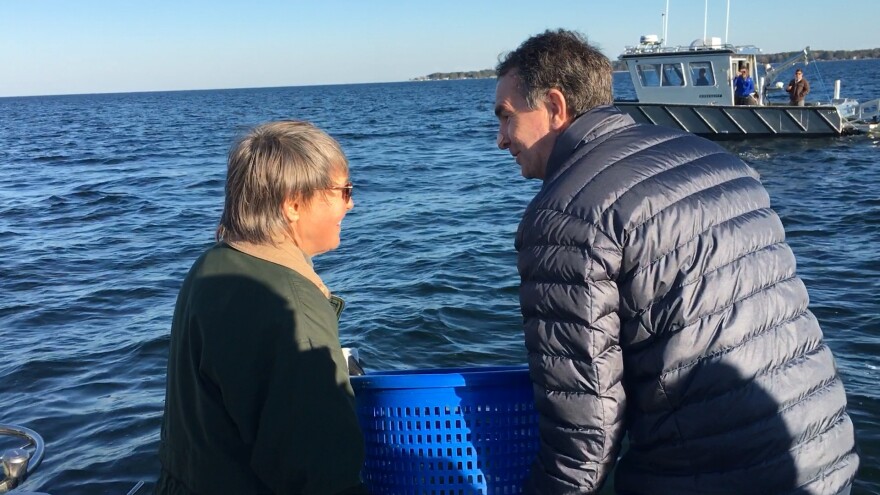Motoring out on the Piankatank River on an iconic Chesapeake Bay deadrise, Governor Northam and Secretary of Natural and Historic Resources Ann Jennings headed to a completed oyster sanctuary reef. There, they dumped a basket of rocks signed by those who made it happen. Cheers went up from

all the collaborators. Among them: NOAA, the Virginia Marine Resources Commission, The Nature Conservancy, the Army Corps of Engineers, Chesapeake Bay Foundation and some of Virginia’s largest oyster companies.
This was no small undertaking. At just over 400 acres, this one is the largest completed oyster sanctuary in the world and the largest of three other sanctuaries completed in Virginia that total a thousand acres. "Each one of these restoration sites represent some of the largest restorations projects in the world," NOAA's Sean Corson explained. "Restoring oysters is really important because they help clean the water, create fish habitat, they create juvenile oysters that spill over and repopulate other areas. They provide a lot of benefits to society, just not harvest."
If you haven’t heard it before, oysters in the Chesapeake Bay are down to only about 2% of their historic population. So sanctuaries are key. "That’s a thousand acres of oyster habitat. That’s a big farm in the west where I grew up," Locke Ogens, Virginia director of the Nature Conservancy, explained. "But we’ve got a lot more to do."
Besides the Piankatank, river sanctuaries are complete on the Lafayette, the Great Wicomico, with an added fourth, the Eastern branch of the Elizabeth. They have become a model bringing visitors from around the world.

Governor Northam who grew up on the Eastern shore said the bay defined his political career. "The reason I got into this particular job of policy-making is I literally watched the demise of the bay over the years. When I was growing up we could pole around and there were so many crabs you could catch as many as you wanted and fishing," he remembered.
Restoring oyster reefs has been an uphill battle, from a shortage of oyster shells to bay budgets slashed by the Trump administration. And it hasn’t been cheap. So far, restoration has cost some $65 million bay-wide and about $6.4 million, in Virginia.
Here, restoration has been a bipartisan effort with $10 million in 2020 from the General Assembly. "It’s not only important for our quality of life in Virginia but it’s also part of our economy," Northam noted. "It brings in billions of dollars, literally every year."
That’s because Virginia’s largest oyster companies benefit from the sanctuaries that help clean the rivers where the industry grows and harvest oysters on nearby leased and private river bottoms. Tommy Kellum's company, Kellum Brothers Seafood, did all the restoration work on the Piankatank. "This is an extremely neat project for the industry. By working together we were able to save about 20 percent of what this project would have cost on a typical oyster restoration. So, it equates to about $2 million extra restoration work we were able to do. And the overall goal is all the same - more oysters and a healthy environment. So we were really excited to be a part of it."
And there’s one more way industry benefits. When oysters reproduce not only will the sanctuary grow but some of those baby oyster larvae will float onto some of their grounds where they will attach, reproduce, and eventually grow to harvest size.
This report, provided by Virginia Public Radio, was made possible with support from the Virginia Education Association.

